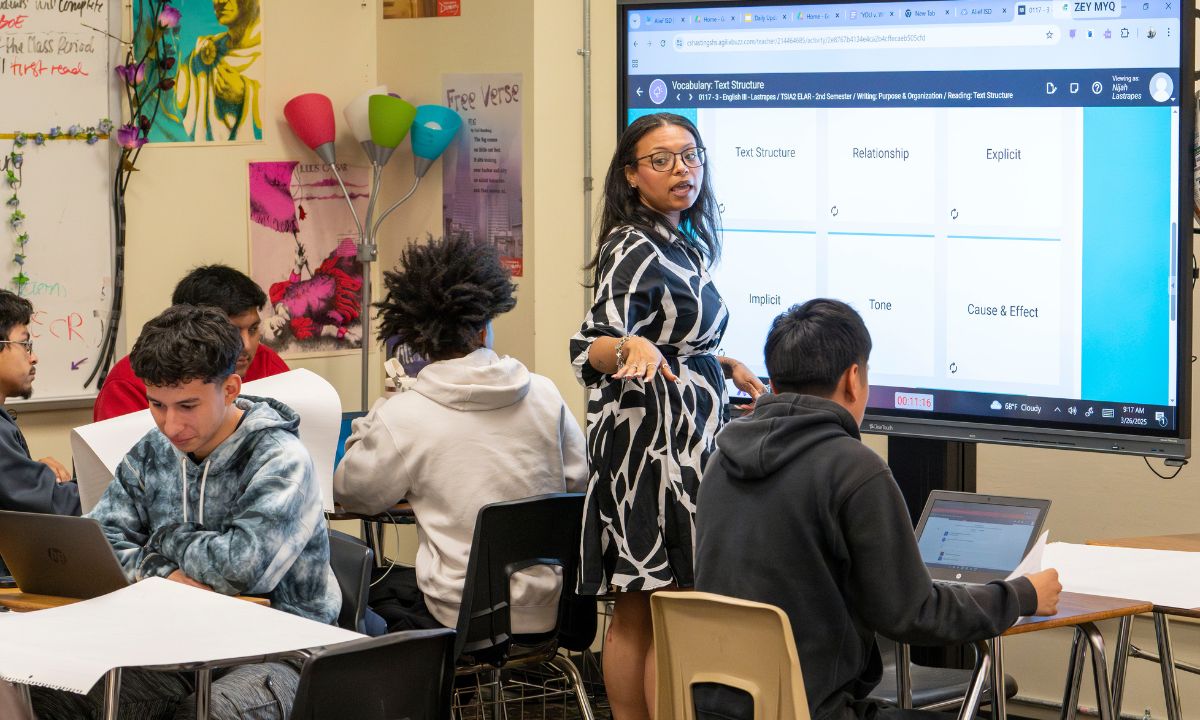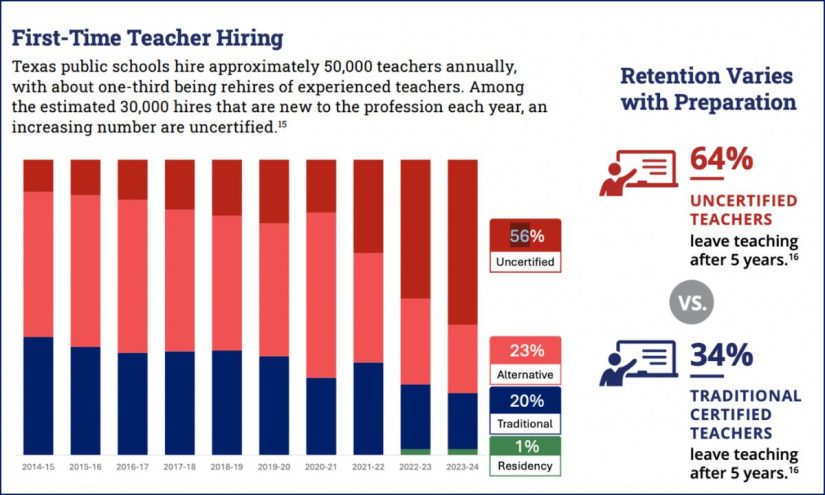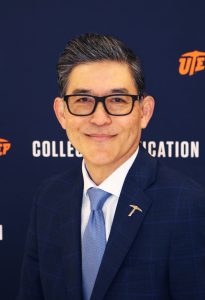A ‘Texas-Sized Solution’ to a ‘Texas-Sized Problem’: Ed Bill Signed into Law
School leaders and experts applaud passage of $8.5 billion education bill, with targeted spending for teacher raises and preparation programs.

Get stories like this delivered straight to your inbox. Sign up for The 74 Newsletter
A decade ago, Texas decided to ease up on its certification requirements and open an alternative pathway for new teachers. The result: More than half of the state’s new public school teachers have no certification, and nearly 1 in 5 haven’t even graduated from college. What’s more, these changes have contributed to weaker student outcomes and continued teacher turnover, research shows.
Advocates are hopeful that change is coming: This June, Gov. Greg Abbott signed into law House Bill 2, a historic $8.5 billion piece of legislation devoted to increasing education funding across the state, with a particular focus on teacher training and retention. It includes almost $190 million specifically devoted to teacher preparation and certification programs, as well as $4 billion for teacher and staff pay raises to keep high-quality teachers in the classroom.
“I don’t think about this being your kind of traditional state policy, which tends to do a lot of patchwork reforms,” said Jacob Kirksey, associate professor at the College of Education at Texas Tech University. “This really tackled the teacher pipeline from its inception.”
The teacher pipeline issue “was a Texas-sized problem,” he added, “and this [bill] is a Texas-sized solution.”
Before this legislative session, Texas lawmakers hadn’t raised schools’ base funding or passed a comprehensive education finance package since 2019, leading to what some called a dire situation. Last year, the K-12 school system was ranked 29th in the nation overall and 44th for reading scores.
The certification crisis became a major focus of the bill once lawmakers “started to recognize that the [resulting] learning loss was a statistic that you couldn’t turn away from,” Kirksey said.

In response, House Bill 2 will also limit some components of a 2015 policy, which allowed the vast majority of Texas districts to hire fully uncertified teachers, experts told The 74. Initially designed with a goal of opening educator pathways for industry folks to teach career and technical education courses, consequences of the Districts of Innovation bill really exploded post-pandemic, when schools were struggling to hire teachers, according to Kirksey.
Ultimately, over 80% of schools statewide applied for and received Districts of Innovation designation, allowing scores of them to hire uncertified teachers. By the 2023-24 school year, the share of all new public school teachers in Texas who are uncertified reached 56%. That share has increased significantly over the last decade, worrying advocates, experts and district leaders across the state. The previous year, when just under half of new teachers were uncertified, almost three-quarters had no prior experience working in Texas public schools.
That lack of preparation has real impact, both for the teachers themselves and the students they serve: 64% of uncertified teachers leave the classroom after just five years — compared to about a third of traditionally certified teachers, according to the Texas Education Agency.
“It was really creating a revolving door of teachers that sort of became a self-fulfilling prophecy,” said Ryan Franklin, managing director of policy and advocacy at Philanthropy Advocates and former associate commissioner for educator leadership and quality at the Texas Education Agency.

Students with new, uncertified teachers lose about four months of learning in reading and three months in math each year, comparable to and compounding the learning loss kids experienced during the pandemic, Kirksey’s research found.
The new legislation gradually mandates that all core subject teachers are fully certified by the 2027-28 school year, with an option for schools to apply for an extension until the 2029-30 school year. It also provides incentives for teachers who are currently in the classroom to seek out certification quickly with a $1,000 bonus.
In addition, the bill looks to promote high-quality training programs since “all preparation is not created equally,” Franklin said.
A ‘chance at sustainable growth‘
While the scale of House Bill 2 is unprecedented in Texas, the desire to introduce innovative and high-quality pathways to teaching isn’t new.
Clifton Tanabe, the dean of the College of Education at The University of Texas El Paso, has been working on this for quite some time. Six years ago, he introduced a residency program to his university to train teachers differently, so they were not just certified but truly prepared to enter some of the most difficult-to-staff urban and rural classrooms.
Residencies are a year-long, intensive form of training that pairs pre-service educators with a mentor teacher and single school site, allowing them to be fully immersed in a classroom environment and learn through doing. Teaching responsibilities often ramp up for the residents throughout the year, allowing them to “get their hands dirty,” as one researcher put it, with training wheels.
Although essentially full-time jobs, they are often unpaid and done while the resident is simultaneously attending their own classes and paying tuition, making them historically inaccessible to a predominantly low-income student body like Tanabe’s. So, he started “pounding the pavement, asking for money,” and ultimately, in 2018, was able to launch a pilot program that offered all residents a yearly stipend.
Despite the program’s success, it wasn’t sustainable. Without COVID funding, Tanabe wouldn’t have the necessary money to keep paying residents. Already, this year, he’s had to cut back yearly stipends from $20,000 to around $14,000.

That changed this June with House Bill 2, which Tanabe called “massive” for his program and the students they serve.
“It’s what we think about as our chance at sustainable growth for this model,” he added.
The legislation will use a variety of mechanisms to get money into schools, ranging from an expansion of the Teacher Incentive Allotment, a merit-based pay program, to the creation of a Teacher Retention Allotment, which will provide significant raises to core subject educators who have been in the classroom for more than three years. Teachers in smaller districts will get even bigger bumps.
In addition, the sweeping bill expands career and technical education, introduces special education reforms and increases funding to charter schools.
On the preparation side, the state will pay the cost of training teaching candidates, up to 40 in residency programs or 80 traditional student teachers in each district. Districts will receive up to $39,500 a year for each teacher resident and $21,500 for each student teacher. Along with the additional funds comes tightened requirements for program content — including mandatory reading and math academies and a ban on any critical race theory-related curriculum.
Historically, around 20% of certified Texas teachers were prepared fully online, asynchronously, meaning they accessed the materials on their own schedule and without real-time live instruction, according to Kirksey’s research. Candidates could get a temporary certification in a matter of weeks and immediately enter the classroom.
“That just shows you the incentive structure that was happening,” Kirksey said.
“What [the new funding] does is it allows them to choose quality and not have the same kind of economic loss that they would have,” he added.
Wes Corzine, superintendent of Huckabay Independent School District, a small, rural district south of Fort Worth, said because of the bill, he’s able to give raises up to $8,000 a year to his more experienced teachers. While he’s excited about the increase in pay and the funding for his district’s residency program, he did push back on one element of the legislation, noting he wished there was a bit more flexibility in how districts could spend some of the money.

Tricia Cave, a lobbyist at the Association of Texas Professional Educators, also argued that the Teacher Retention Allotment funds only support raises for core content classroom teachers, excluding scores of other school-based staff like librarians, counselors and school nurses. Still, she is optimistic about the changes this bill can bring.
For the residency at El Paso, and others like it, the money can’t come soon enough. This year, Tanabe has 200 residents working in schools across seven urban and rural districts that are particularly challenging to staff. The vast majority of the student teachers receive federal Pell grants, and about a third come from families making less than $20,000 a year.
“It’s a student population that’s tenacious, looking for opportunities, working hard and if you give them a realistic program, with the kinds of supports that a residency model with a stipend has, we can succeed at a very high level,” he said.
In the first six years of the program, they’ve already seen promising results and a high percentage of residents are ultimately offered full-time teaching roles at their school sites. Last year, leaders in one district that Tanabe’s program partners with told him the residency program had solved their teacher vacancy problem. This is particularly significant in rural districts, where in the 2022-23 school year, uncertified teachers were hired at a rate four times higher than the rest of the state.
And, because of their intensive training, these teachers “start day-one ready,” and remain in the classroom “because they’re not crying in the parking lot after week one, saying this was the worst decision of their lives. They know how to teach from the get-go,” Tanabe said.
Corzine echoed this point, noting that whenever his district has an opening, they make an effort to hire a resident, “because you’re really hiring a second-year teacher … It creates this huge talent pipeline. It’s a yearlong job interview.”
Experts across the field are hopeful that these across-the-board investments will ultimately have a substantial positive impact on schools, teachers and their students.
“I think we know with the teacher education pieces, this is about the long game,” said Franklin, the Philanthropy Advocates managing director, “and this is about long-term, sustainable ways to ensure that our students have the teachers they deserve, and that the teaching profession is an attractive profession to the end.”
Get stories like these delivered straight to your inbox. Sign up for The 74 Newsletter

;)
